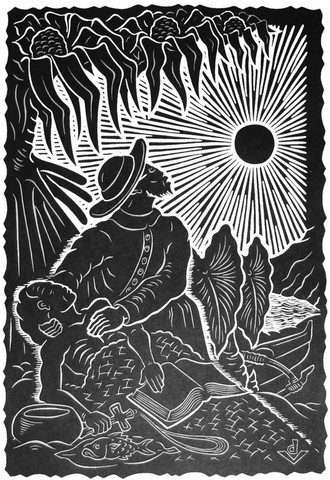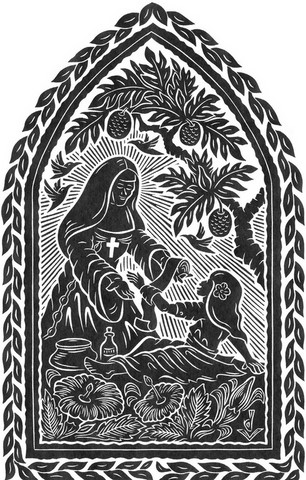What would Hawaii's Saints Do?
Hawaii Catholic Herald
Newspaper of the Diocese of Honolulu

What would Hawaii’s saints do?
09/07/2017 by Hawaii Catholic Herald
Timeless virtues of St. Damien and St. Marianne of Molokai guide modern day faithful
By Darlene J.M. Dela Cruz Hawaii Catholic Herald
Unconditional love. Respect. Graciousness.
Catholics today are prayerfully seeking answers to the problems of a world torn by destruction and division. For several local religious, the enduring Gospel virtues that guided Hawaii’s two saints in crippling crises of the past provide light in our current tumultuous times.
The Hawaii Catholic Herald asked local nuns and priests from the religious orders of St. Damien De Veuster and St. Marianne Cope to reflect on the question, “What would Hawaii’s saints do?”
Sacred Hearts Father Herman Gomes, Sacred Hearts Sister Helene Wood and Sister Alicia Damien Lau of the Sisters of St. Francis of the Neumann Communities will speak about the Islands’ saints at the first-ever Damien and Marianne Catholic Conference.
The event, Oct. 20-22, will be held at the Hawaii Convention Center near Waikiki. They and other Damien and Marianne Catholic Conference guests will celebrate the faith with activities and talks highlighting the theme, “Saints for Life.”
“The church elevates or holds up the lives of holy people so that they can become an example of Gospel-based life centered in Jesus,” Father Gomes told the Herald. “The attributes that (the saints) embody — patience, perseverance, compassion, prayerfulness, faithfulness, kindness, charity, humility, trust in divine providence — become a pattern for us to follow in our own vocation.”
Artwork by Big Island artist Dietrich Varez depicts St. Damien De Veuster aiding Hansen’s disease patients.
St. Damien, selfless outreach
Father Gomes explained that Catholics are inspired and aided by the “communion of saints” in all things. Facing issues in the family, in politics and health, economic and social injustice, and environmental challenges, Catholics look to the saints to help connect this world with God’s helping hand.
“We have a lot of friends in heaven who care for our well-being,” Father Gomes said. “These men and women who have gone before us, who are alive in Christ, can help us by their prayer and intercession to the Father.”
Devotees of St. Damien today see him as a role model and spiritual friend for people who struggle with sickness and loneliness, and for those who reach out to the vulnerable.
St. Damien arrived in Hawaii from Belgium in 1864. He was ordained a priest at the Cathedral of Our Lady of Peace. In 1873, Father Damien landed in Kalaupapa, where he served Hansen’s disease patients banished to the isolated Molokai peninsula. He died there of leprosy in 1889. Father Damien was canonized in 2009.
Sacred Hearts Sister Helene Wood said St. Damien exemplifies “compassion and unconditional love, especially for those in need, those abandoned.”
“During the time of St. Damien, the ‘scourge of leprosy’ forced the government to impose laws that violated the culture of the Hawaiian people,” Sister Helene said. “It is difficult to live this spirit of cooperation in a society that fosters a ‘me first’ attitude, but to live aloha is at the very heart of our Hawaiian community.”
Sacred Hearts priests, sisters and brothers are now engaged in outreach work all over the world. In India at the Damien Institute, for example, religious continue to care for leprosy patients, while fighting to stop human trafficking.
Sister Helene imagined that if St. Damien were alive today, he would be a fierce humanitarian advocate.
“In our modern times where so many people are homeless, or the larger immigration situation where people are leaving their homelands because of violence and war, I believe that St. Damien would speak up,” Sister Helene said.
Father Gomes said St. Damien’s values can be carried on by the faithful in everyday life.
“A man came to me to tell me how impressed he was with the life of Father Damien,” Father Gomes explained. “He jokingly said, ‘I would rather do what Father Damien did in working with the people of Kalaupapa than raising a 16-year-old son.’”
“That’s the point,” Father Gomes added. “His job is to raise the 16-year-old with the same virtues and passion that drove Father Damien to live for other people.”

* Artwork by Big Island artist Dietrich Varez depicts St. Marianne Cope aiding Hansen’s disease patients.
St. Marianne, with a smile
Sister Alicia Damien Lau of the Sisters of St. Francis of the Neumann Communities often visits Kalaupapa in her work as a healthcare consultant. There, St. Marianne Cope more than a century ago brought beauty and joy to patients living in the darkness and desolation of leprosy.
Sister Alicia said the issues St. Marianne faced still exist.
“We will always have ‘outcasts’ among us,” Sister Alicia said. “The world today seems to be built on deception, mistrust, anger and pain. It is manifested through the violence, killings, racism, that we see daily in our country and internationally.”
St. Marianne, she noted, disarmed such tensions with kindness and candor.
“Mother Marianne would, in a calm, gentle voice with a sweet smile, and with firmness, help portray the unconditional love she has for everyone,” Sister Alicia said. “Even when there was injustice being done to her, she did not turn her back to it.”
St. Marianne came to Hawaii in 1883 from Syracuse, New York. She and six companion Franciscan Sisters answered a plea from the Hawaiian Kingdom to aid in its leprosy crisis. St. Marianne opened a hospital on Maui, and in 1888 moved to Kalaupapa where she opened Bishop Home for female patients. She died in Kalaupapa in 1918, and was canonized in 2012.
Sister Alicia called St. Marianne “a woman ahead of her time” who had “total faith and trust in God.” The saint taught others respect, and “her heart went out to everyone feeling their pain and sorrow.”
She cites a quote written by St. Marianne: “What little good we can do in this world to help and comfort the suffering, we wish to do it quietly and so far as possible, unnoticed and unknown.”
“These were ordinary people — Damien, Marianne — who listened to what God had called them to do,” Sister Alicia said. “They did ‘extraordinary’ things for his people. We are all special in God’s eyes, and he has called us to go beyond ourselves to continue the work that Damien and Marianne had begun.”
This article is the first in a four-part series highlighting speakers and perspectives to be shared at the Damien and Marianne Catholic Conference. In the next Hawaii Catholic Herald issue, DMCC speakers will explore the topic, “Our unique Island faith community.”
